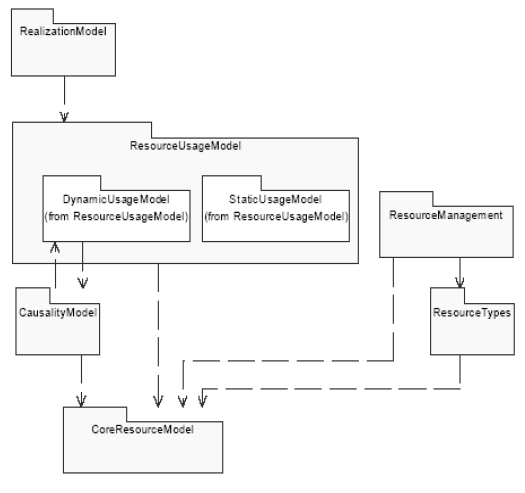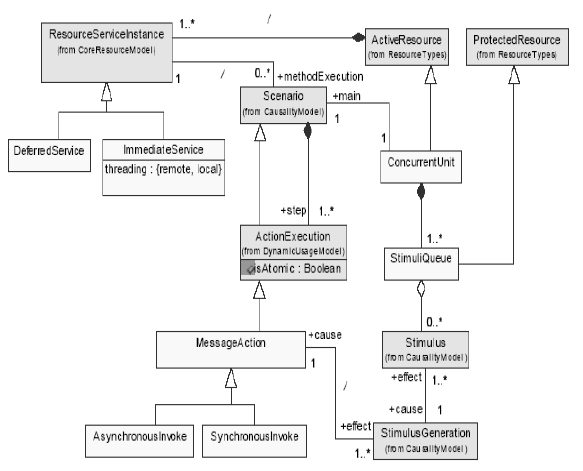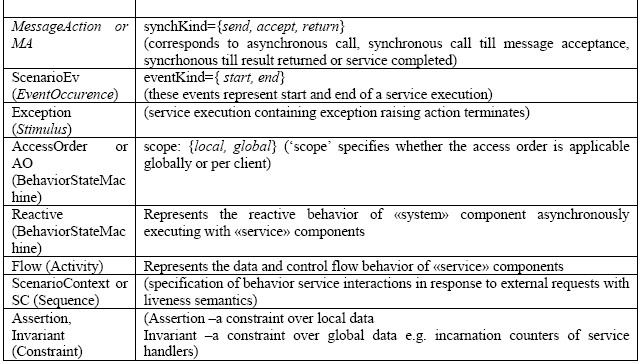AbstractComplex software systems possess concurrent and reactive behaviors requiring precise specifications prior to development. Lamport's transition axiom method is a formal specification method which combines axiomatic and operational approaches. On the other hand Unified Modeling Language (UML), a de facto industry standard visual language, lacks suitable constructs and semantics regarding concurrency aspects. Though UML includes action semantics, its higher level constructs and object semantics are inconsistent. Motivated by Lamport's approach, this paper proposes a UML based specification framework 'cmUML' ('cm' for concurrent modules) for formal specification of concurrent, reactive systems without object level diagrams and OCL. The framework integrates higher level diagrams of UML and addresses various concurrency issues including exception handling. It combines UML-RT and UML/ SPT profile as the latter defines a core package for concurrency and causality. Further the framework includes the characteristic safety and liveness aspects of concurrent systems. The proposed framework is in contrast with existing approaches based on low level primitives (semaphore, monitors). The paper includes several specification examples validating the proposed framework. 1 INTRODUCTIONIn spite of proliferation of modern technologies, development of complex systems with concurrent, reactive behaviors remains a challenging task. The difficulty is largely due to the conceptual gap between the complex domains and the implementation technologies which requires formal yet intuitive specification languages and methodologies. There exists a pragmatic approach in formal specification of concurrent systems, for example Lamport's transition axiom method [Lam89, Lam00] which combines axiomatic and operational approaches for arriving at intuitive yet formal specification of complex systems. On the other hand, the visual specification languages like UML (Unified Modeling Language) and Model Driven Architectures (MDA) are emerging as new paradigm for development of complex systems. UML has become the de facto industry standard visual specification language [OMG02, Selic04]. Current UML methodologies for example COMET, CODARTS [Gomaa00], are largely based on informal design heuristics with focus on static aspects of the systems. Behavioral specifications of these approaches are largely representative lacking completeness and precise semantics. Further, these approaches specify concurrency using low level primitives like semaphores, monitors, and threads. There exist formal approaches in UML with precise semantics, for example RT-UML [DJPV02], UML-RT [CG01], and UML/SDL [ITU00]. These approaches aim at real-time, embedded domains using a subset of UML features. For example, these approaches are largely based on statemachine semantics and do not integrate other behavioral aspects like data/ control flow, concurrency, synchronization etc. RT-UML provides semantical foundation to UML regarding concurrency, and communication. UML-RT and SDL/ UML are architectural approaches with focus on control-based reactive behaviors. But, none of these approaches handle higher level concurrency issues like multiple operation invocations, synchronization semantics. The proposed framework (named cmUML where 'cm' stands for concurrent modules) provides higher level architectural abstractions with precise operational semantics for specifying concurrent, reactive behaviors in terms of action, activity executions. As UML lacks formal semantics, cmUML provides much required unifying framework integrating action semantics, active/ passive objects, and higher level diagrams towards precise formal specifications (independent of design or implementation aspects). To strengthen the emerging paradigm of visual specification languages and model driven architectures with the rigor of formal specification approaches, higher abstractions with precise semantics are required. It is also necessary that such abstractions should be intuitive for the developers of the system. Lamport's transition axiom method [Lam89, Lam00] (henceforth referred as TAM) recommends module based specification of systems where the modules (called 'components' in cmUML) are specified in terms of precise interface, and internal specifications. In this method, the internal specification resembles a higher level design of the module as the necessary system variables (PC, call stack, etc) can be used to represent the execution state. These variables are explicitly updated in response to module actions under safety and liveness constraints. The TAM approach is independent of any specification language. Its higher level design approach makes it convenient for adoption with UML framework. In this paper we extend UML (using its lightweight extension mechanisms) to define abstract architectural components with precise operational semantics. Further, these components are associated with UML's higher level diagrams retaining the benefits of its multi-view approach. In this regard, the main contributions of this paper are listed below.
To implement TAM approach, the proposed framework combines UML-RT and SDL/ UML (for compositionality, formal semantics) and the UML/ SPT profile [OMG02] (for basic elements of concurrency and causality). The rest of the paper is organized as follows. In section 2, we give a brief overview of UML-RT, SDL/UML and SPT Profile. The proposed framework is defined in sections 3. Section 4 discusses a case study specification of vending machine, a classical problem in the literature. In section 5, we validate the profile through specification of classical concurrency patterns. We discuss related works in section 6. An approach for formal semantics definition is discussed in the appendix. 2 OVERVIEW OF UML-RT AND SPT PROFILESThe conventional UML mechanisms for specification of concurrency are: active/passive objects, concurrency attribute of passive objects, concurrent regions of statechart, and concurrent actions. But as UML lacks a formal semantics, these mechanisms are not semantically integrated with the underlying object model resulting in inconsistent and ambiguous design models [GO01, Ober99]. UML-RT (similar to SDL/ UML in many aspects) is an architecture description language in UML. UML-RT (based on actor paradigm of ROOM language [SGW94]) defines architectural concepts as UML stereotypes. Specifically, it adds following stereotypes of standard UML elements (given in parenthesis) for modeling run-time structures.
cmUML adopts the notion of capsules, sub-capsules and ports of UML-RT (for compositionality) but not connector as it can be specified as an implicit association or as a component itself in case of complex associations (e.g. delaying channels). The SPT profile (the standard UML profile for schedulabiloity, performance, and time [6]) was defined as a standard way to annotate the UML specification of real time systems towards automated quantitative analysis. It defines a generic resource modeling framework with abstract concepts allowing further extensions and mappings onto UML elements. Our decision to extend SPT is particularly relevant as the profile defines a concurrency package with abstract concepts like 'ConcurrentUnit', 'Scenario', 'ActionExecution' etc. The core 'CoreResourceModelingFramework' package with the concurrency sub-package can be regarded as the kernel of the profile (see fig.1). Some important concepts of SPT profile as relevant here are: Instance and Descriptor (a run-time entity and its design time descriptor i.e. type); EventOccurence, Scenario, and ActionExecution define causality in the model; Scenario represents a sequence of actions (and sub-actions) with associated partial ordering representing concurrency. cmUML extends the concepts of SPT profile with precise semantics and compositionality towards behavioral specification as an abstract architectural language (a la UML-RT).
Figure 1.(a) GeneralResourceModeling package
Figure 1. (b) Concurrency package Figure 1. UML/ SPT profile packages at 'kernel' level 3 PROPOSED FRAMEWORK AND THE PROFILEWe follow SPT profile approach in defining the conceptual framework and the corresponding UML mapping. First we introduce conceptual elements of the framework in a class diagram notation (not related to UML metamodel) and then map these onto UML metamodel using standard extension mechanisms. The conceptual diagram represents the basic abstractions and their relationships (see fig.2). We also describe the semantics informally (the formal description approach is outlined in the appendix). In cmUML, a component is a generic entity (representing the type or descriptor of corresponding runtime instances) with specific functionality and behavior specified in terms of actions or activities under reactive or flow semantics. A component may be concurrent or sequential based on internal concurrency (i.e. concurrency is due to interleaved executions or alternating executions in run-to-completion). Depending on functionality and behavior the components are further classified as system, state, port, service, and resource. System component contains other components and responsible for their initialization. Resource component with abstract operations 'acquire', 'release', 'read' and 'write' represent a passive, protected data or hardware resource. Resource components with complex behavior may be specified as system components. State component represents reactive, synchronization, and exception handling aspects of internal executions. Port component represents interface specification with concurrency aspects, service access order, and inter component communication. Services are dynamic components instantiated in response to external requests in contrast to asynchronously executing State, and Port behaviors. An instance of a service may execute concurrently with itself and other compatible services. Action and activities are simple or guarded (with precise semantics). Guard expressions represent local assertions or global invariants representing synchronizations and exception handling in concurrent environment. A ScenarioContext represents interactions of component executions in response to external events with necessary liveness semantics and event ordering constraints. In Table. 1 we define the corresponding UML profile using UML extension mechanisms stereotypes, tags and constraints (corresponding concepts of SPT profile are represented in italics). Also associations are represented via tags in cmUML as the profile does not use explicit associations. Stereotype or a UML name as tag type in the table indicates reference to the corresponding instance. Also absence of multiplicity indicates 0 or 1 where as * indicates 0 or more. The cmUML profile uses 'flat' versions of behavioral specifications i.e. activities, statecharts, and sequence diagrams without hierarchy as such features can be syntactically translated into equivalent flat versions. Also abstract methods are defined for a few abstractions (e.g. state, resource etc) to simplify the semantics description as well as make the specifications intuitive to system developers.
Figure 2. Conceptual model of the proposed specification framework
Table 1. cmUML profile for the proposed framework cmUML Semantics DescriptionIn the rest of this section, we informally describe the semantics of the cmUML specificaitons (see appendix for formal description approach). One of the main constructs defined in the profile is ActivityExecution as a generalization of SPT Profile's ActionExecution (consistent with UML definition of activity as an action). Activities are at a higher granularity than actions and represent a service. A service is associated with a run-time handler 'ServiceHandler' in 'port' component with information regarding service instances that started and completed (using incarnation counters in and out). This information can be used to specify complex synchronization patterns in the form of global invariants representing safety conditions in a simpler way [JS07, Miz99]. A set of useful global invariants are proposed [Miz99] which work as basic patterns to compose appropriate global invariants for specifications. Translations exist from global invariant based coarse-grained specifications to fine-grained synchronization code using semaphore, monitors etc. Another important construct defined in the profile with respect to concurrent execution characteristics is GuardedAction. This allows specifying precise semantics corresponding to the guard evaluation and the execution of the corresponding action or activity (see fig.5). The GuardedAction specifies synchronization (i.e. wait semantics) and exception handling. The exceptions are handled by corresponding 'state' component or thrown into higher level 'state' components (a la java try-catch block). Thus GuardedAction provides much needed specification construct for synchronization, exception handling behavior of sequential executions in concurrent environment [Lohr92]. Communication aspects of cmUML components are externally message based (suitable for distributed environment) and internally message, or shared resource based.
4 A SPECIFICATION METHODOLOGYIn this section, we propose a step-wise specification methodology for the application of cmUML. The methodology assumes use case based requirement analysis and a higher level decomposition strategy for arriving at the initial subsystems [Goma00]. For the case study below there is only one subsystem which can be taken as the initial «system» component. For a complex system there may exist many subsystems for which the methodology can be applied separately. We describe the specification approach in terms of the following tasks. Task1 : Identify the component interface with services offered. The information can be obtained from requirement artifacts like problem statement, use cases, and context diagrams. Task2 : Determine the concurrent execution behavior of interface services (serviceKind and other tags) and their temporal ordering dependencies as observed externally. This information is specified as the 'AccessOrder' behavior of the corresponding 'port' component. AccessOrder is a behavior statemachine and transition guards may include expressions over incarnation counters of 'ServiceHandlers' corresponding to interface 'ServiceTypes' of the 'system' component. The AccessOrder specification also aids in component decomposition as explained next. Task3 : Considering the information obtained in above task, perform the component (or subsystem) decomposition to find the internal (behavioral) structure by dividing the interface services into a set of concurrent groups of services. This decomposition can be fine-tuned by applying the general task cohesion principles from OOAD approaches (e.g. functional cohesion) [Goma00]. Each of these concurrent groups can be specified as a subcomponent. For simple components with no internal structure, this step is skipped. Task4 : Corresponding to each use case, specify one or more 'ScenarioContext' involving interaction between 'system', 'service', 'port', 'state', and 'service' components with liveness semantics and explicit event orderings. Also, the control and reactive aspects are specified as a 'state' component using behavioral statemachine and may be represented in ScenarioContexts of the component. Task5 : Specify services of 'system' components as UML activity diagrams (flows), identifying the functions to be implemented and specifying 'Guarded' actions or activities (and associated atomicity) if any. Task6 : Further refine the 'service', 'state', 'ScenarioContext' specifications by identifying synchronization, exception handling aspects among the concurrently executing 'services' and 'state' components. This includes identifying appropriate invariants (by identifying 'guarded' actions or activities), and exception handling activities for the 'state' component.. This task also includes identification of external/ internal events and component responses. Task7 : Repeat above tasks for 'system' sub components identified in task2. We elaborate above tasks with a case study. Consider the UML specification of a vending machine, a well known specification example in the literature for example in [ITCB04]. A vending machine (VM) accepts coins from users to dispense a drink of chosen choice. The user gives coins, one at a time, and when the sum is sufficient enough the corresponding choices of available drinks are displayed. The user can select any of enabled choices. The drink and the extra coins, if any, are dispensed (for simplicity, we assume that the VM doesn't remember the coins of previous transactions). Also the user's request to cancel the transaction may be considered.
Figure 3. «port» specification of temporal dependencies among the interface service invocations for VM Task1 : Interactions of the system with its environment (i.e. user) is considered. The user 'gives' sufficiently more coins and when prompted by the VM 'selects' his choice of the drink. The VM, after 'validating' the choice and the received coins, 'dispense s' the 'drink' as well as the 'balance' coins if any. From the first analysis of external interaction we can observe four main services of the VM, involving its environment (user): ReceiveCoins, ReceiveChoice, DispenseDrink, and DispenseCoins (denoted concisely as R-Coins, R-Choice, D-Drink, D-Coins) (see fig. 3).
Figure 4. Structure and «state» specification of «system» Component VM Task2 : During this task, we determine the possible concurrency and temporal dependency between the component services as observed externally. This is specified as 'AccessOrder' in figure 3. The specified tag value 'scope' is redundant in this example as only a single user is involved at a given time. The complete interface specification («port») includes concurrency aspects of all ServiceTypes of the component (as observed externally). For VM, all service types have similar tag values {isAtomic= false ; serviceKind= write ; max=1} with additional information that D-Drink, D-Coins may execute in parallel. The semantics of these tags is also operationally specified in the corresponding 'AccessOrder' specification. Task3 : From figure3 we observe a concurrent region and a sequential region in dashed border. Now following task cohesion principles of OOAD approaches [Goma00], we can identify two concurrent components with functionally related services; a 'Cash Exchanger' component (CE) (that handle interface services R-Coins, D-Coins) and a 'Drink Dispenser' component (DD) (that handle interface services R-Choice, D-Drink). The temporal dependencies specified as part of interface specification need to be preserved in the internal specification. This is done through the specification of «state» component of VM in figure 4. Task4 : For simplicity we assume 'Env' represents the 'port' component and includes the hardware interfaces through which user interacts with VM (e.g. choicePanel, coinSlot, etc). Now, we can specify the ScenarioContexts of VM (see fig.6 which includes all the contexts for brevity). Only specified events under given liveness constraints are of interest to the context with respect to system behaviors which may include other 'unspecified' internal events, actions etc (a la Lamport's 'stuttered' transitions). In this specification, all solid notations, for example life-lines or segments there of (representing executions) and message actions, represent compulsory or liveness notion of mandatory behavior while dashed ones represent optional behaviors [14].
Figure 6. A «scenarioContext» specifies primary behavior of VM component with liveness semantics Task5 : The computational aspects of component services are specified in terms of the implementation level activities using activity diagram (with data and control flow semantics). Fig.5 specifies the 'flow' behavior of the 'service' R-Coins with necessary guarded semantics. The associated tag values specify that the service execution does not wait for guard value to become true and terminate by raising an exception. 'GuardedActions' are useful to specify atomic update of shared data values (isAtomic= true) or synchronization semantics regarding guard evalution. In this context atomicity indicates that the guard value can not change during execution of the action(s) (in fig.5 the outer guard corresponding to drinks availability cannot change during execution of R-Coins behavior). Also a guard expression may declaratively specify a condition referring to old and new values of shared data using notation e.g. x@preAU and x@postAU enhancing expressiveness of specifications [Lam00]. Task6 : Now we can further refine the various specifications. We can identify 'guardedActions' with guards as invariants over incarnation counters in, out of serviceHandlers of component ServiceTypes specifying service synchronizations if any (This is required while compiling higher level specifications with internal activities that need to be synchronized. These activities can be specified as separate 'internal' services). We can also specify exception handling activities by extending «state» specification. We can also identify external, and internal events and specify corresponding event handling activities. In fig.6 we identified possible external event 'Cancel' due to user's interaction with VM. A new ScenarioContext VM-Cancel is specified. Multiple contexts may be 'enforced' in parallel i.e. in 'interleaved' fashion, over system behaviors (this is possible as 'system' components do not discard events implicitly).
Figure 5. Activity specification of a service with guarded semantics Task7 : We can complete the specification of VM by specifying each «system» sub component (i.e. CE, DD) following previous tasks. We skip these steps here. 5 FRAMEWORK VALIDATION: SPECIFICATION OF CLASSICAL CONCURRENCY PATTERNSIn this section we specify classical concurrency patterns to show merits of cmUML approach over current UML approaches (using low level constructs for e.g. [GE04]). These approaches use low-level primitives like locks, semaphore, monitors etc to describe concurrent behavior where the semantics of these constructs are either not specified or specified in complicated OCL statements. Also in these approaches, though higher level diagrams are used, no precise semantics can be inferred about behaviors of the system specified. In contrast, cmUML specifications are precise without using low level primitives. Readers-Writers Synchronization PatternIn fig.7 we have shown the specification of the pattern in current UML practices (without OCL statements) and in fig.8 using cmUML approach. The proposed approach retains the abstractness of specifications yet providing precise operational behavior. The specification in fig.8 does not use many proposed abstractions (i.e. state, service, scenarioContext) as the pattern is simple and services are primitive. Also the pattern does not possess any reactive or state-based behavior. Hence the interface specification (i.e. 'Port', 'AcessOrder') it self is sufficient. From the specification it is precise that multiple readers are allowed where as a single writer executes in mutual exclusion. Also by 'policy' tag value i.e. as 'FIFO ' with «Port», there is no starvation of 'writers'.
Figure 7. Specification of Readers-Writers synchronization pattern in UML approaches
Figure 8. Specification of Readers-Writers synchronization pattern in cmUML
For 'ServiceTypes' parameters can be specified using tag 'param'(a string defined in BNF form: { in | out : variableName(variableType)}). Producer–Consumer Synchronization PatternThe pattern has state based behaviors. Fig.9 specifies the pattern (invocation behavior of get() vomited) in current UML approaches where as fig.10 is the corresponding cmUML specification. Though fig.9 includes behavior specification using UML sequence diagram, it is not formally precise.
Figure 9. Specification of Producer-Consumer synchronization in UML approaches
Figure 10. Specification of Producer-Consumer synchronization pattern in cmUML The cmUML specification of the pattern (fig.10) uses many abstractions of the proposed framework. «Port» and «AcessOrder» specify invocation behavior of interface services. «Reactive» part specifies the state based behavior. «Flow» specifies the important part of the specification i.e. sequential behavior of the «service» Put. It contains the guarded activity 'update' under guard 'notFull' with the specified atomicity indicating that the guard value can not change during execution of the activity. Also the tag values isHot=false and isDelay=true specify that the service execution waits till the guard is satisfied (possibly forever!). The new specification does not use ScenarioContexts as they are not required in this example. 6 RELATED WORKSThere exist several works involving concurrency in UML. We have already discussed UML-RT and UML/SPT Profile. In this section, we briefly look at other works [Ober99, CDC02, DM99, Omar03, DJPV02]. None of these works comprehensively address the issues of concurrency specification from formal specification perspective. Charles Chrichton et.al. proposed a pattern for concurrency specification in UML [CDC02]. This pattern addresses specification of multiple instantiations of operations on an object. The specification approach separates (non-atomic) operation specifications from statemodel specification of an object using different diagrams (i.e. activity and statmachine). This is a formal approach where the operation, and statemodel specifications are converted to CSP process specifications and effects of concurrent executions of operations on the object are examined using FDR model checking tool. But, the approaches based on translation into formalisms fall short of covering the rich range of features in UML. Iulian Ober and Ileana Stan proposed a quasi-concurrent object model for UML's active objects by integrating an existing concurrent object model, namely ATOM, with UML [Ober99]. The proposed extension redefines active/ passive semantics to eliminate involved inconsistencies. Passive objects can not have statemachines. Active objects are quasi-concurrent; an executing method can explicitly yield the control, for example, while waiting for an event. Method invocation is de-linked from the associated statemachine and only signals are processed by the statemachine. The statemachine runs quasi-concurrently with the methods and is notified of method start and end events. Some aspects of the approach are related to cmUML. A UML package for specifying Real-Time objects was proposed [DM99]. The constructs of the approach are based on the objects of the RTSORAC (Real-Time Semantic Objects Relationships and Constraints) model. Concurrency in an object is determined by the Compatibility function (represented as a matrix). Each function parameter is specified as 'read' or 'write' type and compatible functions (i.e. those functions which can execute concurrently) are determined based on their parameter values. The approach causes more overhead but can increase the potential parallelism and thus may be helpful on certain parallel architectures. The aspects of the compatibility function can be found in cmUML. Aspect oriented approaches are being proposed for modeling as well. For example, Omar Aldawaud et.al. proposed a UML profile for aspect oriented software development in UML [Omar03]. The profile defines stereotypes «aspect», «crosscut» etc. Various execution aspects of an object, for example synchronization and exception handling, can be specified as separate «aspect» objects which can 'crosscut' into functionality of the main object in synchronous or asynchronous manner. Werner Damm et.al. defined a subset of UML, krtUML [DJPV02], which is rich enough to express all behavioral modeling entities of UML for real-time systems with formal interleaving semantics using symbolic transition systems (STS) providing the much needed semantical foundation for formal verification of real-time UML models. This work addresses wide range of language issues of UML as well as critical issues of concurrency, and communication. While krtUML is concerened with the complete specification of systems at lower granularity (with concurrency due to concurrently executing sequential objects), cmUML addresses similar issues at higher granularity of specifications (i.e. abstract architectural components) with intra component concurrency. 7 CONCLUSION AND FUTURE WORKIn this paper we have proposed cmUML, a behavior specification framework in UML, by combining and extending the concepts of UML-RT and UML/SPT profile. UML-RT is an architectural description language with focus on real-time embedded systems. The SPT profile defines abstract concepts to annotate models for real time systems towards quantitative analysis. cmUML adds compositionality, and precise semantics over SPT profile to define a behavior specification language. The framework covers wide range of concurrency issues including exception handling. It further adds the safety, liveness aspects of concurrent computations. It also retains the multi-view approach of UML by integrating behavioral diagrams (statecharts, activity, and sequence diagrams) in underlying semantic framework. The proposed framework is independent of class diagrams and OCL (UML's object constraint language). Also cmUML is independent of design aspects like active, passive objects to specify concurrency. The proposed framework is motivated by Lamport's transition axiom method for formal specification of concurrent systems and shows the formal rigor of the method can be followed with UML. As cmUML is based on formal semantics (see appendix and [JS06]) the formal verification techniques can be supported [WMC01, ITCB04]. We intend to further refine the elements of cmUML to make it a formal specification language for Lamport's transition axiom method to obtain the benefits of Lamport's verification techniques in industry standard specificaiton enviroments like UML. APPENDIX: Formal Description of cmUML SemanticsIn this section, we briefly outline the semantics definition approach for cmUML (as given in [1]). In general, defining the semantics of a language L (here cmUML) involves defining a mapping M between elements of L and concepts of chosen semantic domain S (here symbolic transition systems [11]). For this, a formal notation for cmUML specifications is required. The formal notation, a 10-tuple, defines the elements of cmUML as a type structure defining various primitive and complex types. A symbolic transition system, say S, represents a type system of the necessary system variables subsuming the type system of cmUML. The behavioral semantics of a cmUML specification M is defined in terms of elementary transitions (or axioms) of the corresponding symbolic transition system Semantic Module ENV-conf : Detailed description of other semantic modules can be found in [JS06]. REFERENCES[CDC02] Crichton C., Davies J., and Cavarra A., "A Pattern for Concurrency in UML", Oxford Computing Lab, submitted in FASE 2002 [CG01] Shang-Wen Cheng, and David Garlan, "Mapping Architectural Concepts to UML-RT", International Conference on Parallel and Distributed Processing Techniques and Applications (PDPTA'2001), Las Vegas, USA, June, 2001. [DH99] Werner Damm, David Harel, "LSCs: Breathing life in to Message Sequence Charts", In Porc. 3 rd IFIP International Conference on Formal Methods for Open Object-based Distributed System, 1999 [DJPV02] W. Damm, B. Josko, A. Pnueli, and A. Votintseva., "Understanding UML: A formal semantics of concurrency and communication in real-time UML", In Proceedings of FMCO'02, LNCS. Springer Verlag, November 2002 [DM99] L. DiPippo and L. Ma, "A UML Package for Specifying Real-Time Objects", University of Rhode Island, Technical Report, TR99-274, Nov. 1999 [GE04] A. Goni, Y.Eterovic, "Building Precise UML Constructs to Model Concurrency Using OCL", Proc. UML 2004 Conference, LNCS Vol 3273, pp 212-225, 2004 [GO01] Gerard. S., Ober. I., "Parallelism/ Concurrency Specification in UML", white paper, UML Conference, Toronto, Canada, 2001 [Goma00] H. Gomaa, "Designing Concurrent, Distributed, and Real-Time Applications with UML", Addison-Wesley, USA 2000 [ITCB04] Ingo Schinz, Tobe Toben, Christian Mrugalla, Bernd Westphal, "The Rhapsody UML Verification Environment", Proc. of 2 nd Int. Conf. on Software Engineering and Formal Methods (SEFM'04), Beijing, China, pp 174-183, 2004 [ITU00] ITU-T, "SDL combined with UML", ITU-T recommendation Z.109, 2000 [JS06] Jagadish. S., Shayamasundar R.K: "cmUML- A Precise UML for Abstract Specification of Concurrent Components", Proceedings of 18th International Conference on Parallel and Distributed Computing and Systems (PDCS), Dallas, USA, Acta press, November 2006, pp 141-146. [JS07] Jagadish. S., Shyamasunder R.K: "An UML-based approach to Specify Secured, Fine-grained, Concurrent Access to Shared Resources" Journal of Object Technology (JOT), vol.6 no.1, Jan-Feb, 2007, pp 107-119. http://www.jot.fm/issues/issue_2007_01/article3/ [Lam00] Leslie Lamport, "A Formal Basis for the Specification of Concurrent. Systems", Notes for the NATO Advanced Study Institute, Izmir, Turkey. June 26, 2000 [Lam89] Leslie Lamport, "A Simple Approach to Specifying Concurrent Systems", Communications of ACM, vol.32 no.1, pp32-45, January 1989 [Lohr92] Klaus-Peter Lohr, " Concurrency Annotations", Proc. on Object-oriented programming systems, languages, and applications, Canada, pp 327-340, 1992 [Miz99] M. Mizuno, "A structured approach for developing concurrent programs in Java", Information Processing Letters, Vol 69, No 5, pp232-238, 1999. [Ober99] Ober. I., Stan. I "On the Concurrent Object Model of UML", Proceedings of EUROPAR' 99 [Omar03] Aldawud et.al., "UML Profile for Aspect-Oriented Software Development" Proc. 3 rd Int. workshop on aspect oriented modeling, March, 2003 [OMG02] Object Management Group, "UML Profile for Schedulability, Performance, and Time Specification", OMG Adopted Specification ptc/02-03-02, July 1, 2002 (www.omg.org) [Selic04] Selic, B., "On the Semantic Foundations of Standard UML 2.0", Lecture Notes in Computer Science vol. 3185, Springer-Verlag, 2004. [SGW94] B. Selic, G. Gullekson, and P.Ward, "Real-Time Object-Oriented Modeling", John Wiley, New York, 1994 [WMC01] William E. McUmber, Betty H.C. Cheng, " A general framework for formalizing UML with formal languages", Proceedings of the 23rd International Conference on Software Engineering, Toronto, Canada, pp 433 – 442, 2001 About the authors
Jagadish Suryadevara, Lawrence Chung, Shyamasundar R.K: "cmUML – A UML based Framework for Formal Specification of Concurrent, Reactive Systems", in Journal of Object Technology, vol. 7, no. 8, November-December 2008, pp. 187-207 http://www.jot.fm/issues/issue_2008_11/atrticle7/ |
|||||||||||||

















